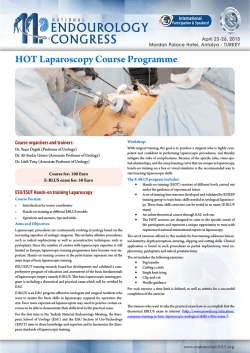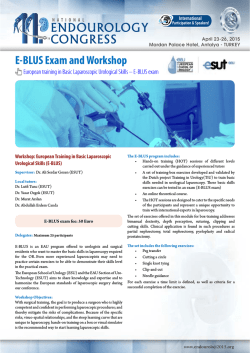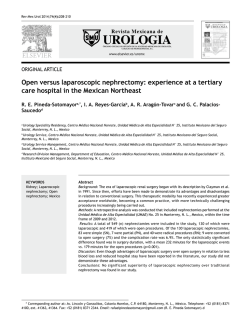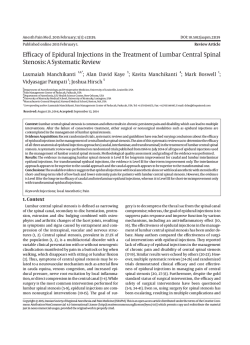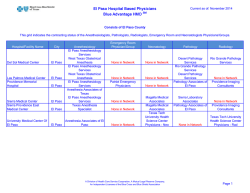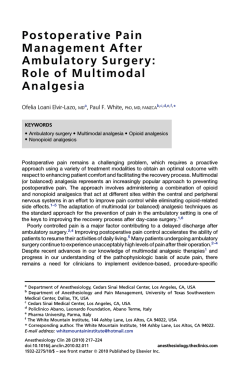
Download [ PDF ] - journal of evolution of medical and dental sciences
DOI: 10.14260/jemds/2015/205 ORIGINAL ARTICLE COMPARATIVE STUDY BETWEEN LEVOBUPIVACAINE WITH CLONIDINE AND ROPIVACAINE WITH CLONIDINE IN THORACIC EPIDURAL BLOCK FOR LAPAROSCOPIC CHOLECYSTECTOMY Abhishek Pandey1, Rajeev Kumar2, Col. L. S. Kang3, Malti Agarwal4 HOW TO CITE THIS ARTICLE: Abhishek Pandey, Rajeev Kumar, Col. L. S. Kang, Malti Agarwal. “Comparative Study between Levobupivacaine with Clonidine and Ropivacaine with Clonidine in Thoracic Epidural Block for Laparoscopic Cholecystectomy”. Journal of Evolution of Medical and Dental Sciences 2015; Vol. 4, Issue 09, January 29; Page: 1457-1465, DOI: 10.14260/jemds/2015/205 ABSTRACT: INTRODUCTION: Laparoscopic cholecystectomy has traditionally been performed under general anesthesia, however, with the development and advancement of newer surgical and anesthetic techniques, approaches using regional anaesthesia are emerging as a viable and useful alternative. This study was conducted to compare the postoperative analgesic efficacy and safety of levobupivacaine with clonidine and ropivacaine with clonidine. MATERIAL AND METHODS: A randomized single-blind controlled trial was done with 60 patients of American Society of Anesthesiologists Grade I or II status undergoing laparoscopic cholecystectomy. Group I (N = 30) (patients n = 30) received epidural anesthesia 0.5% (2 mg/kg) levobupivacaine with 1.2 µg/kg clonidine. Whereas group II (N=30) received epidural anesthesia 0.75% (3 mg/kg) ropivacaine with 1.2 µg/kg clonidine.. Vital parameters were recorded. RESULTS: In both the groups, throughout the procedure, mean heart rate and blood pressure levels were either significantly lower or comparable to the baseline levels. In both the groups most of the times hypotensive effect of anaesthetic agents was observed. CONCLUSION: Levobupivacaine with clonidine provided an early and longer block and showed lesser analgesic need for shoulder pain as compared to ropivacaine with clonidine yet both the groups showed a high decline in blood pressure that necessitated the vasopressor use. KEYWORDS: Clonidine, levobupivacaine, ropivacaine, laporoscopic cholecystectomy. INTRODUCTION: Laparoscopic cholecystectomy has traditionally been performed under general anesthesia, however, with the development and advancement of newer surgical and anesthetic techniques, approaches using regional anaesthesia are emerging as a viable and useful alternative (Tzovaras et al., 2006).1 Generally, these approaches have lower postoperative mortality and fewer complications than general anesthesia and hence use of regional anesthesia seems more suitable for the minimally invasive laparoscopic surgery (Hamad and El-Khattary, 2003).2 Bupivacaine, the widely used local anesthetic in regional anesthesia is available in a commercial preparation as a racemic mixture (50:50) of its two enantiomers, levobupivacaine, S (−) isomer and dextrobupivacaine, R (+) isomer. Severe central nervous system and cardiovascular adverse reactions reported in the literature after inadvertent intravascular injection or intravenous regional anesthesia have been linked to the R (+) isomer of bupivacaine. The levorotatory isomers were shown to have a safer pharmacological profile (McLeod and Burke, 2001).3 with less cardiac and neurotoxic adverse effects (Morrison et al., 2000).4 J of Evolution of Med and Dent Sci/ eISSN- 2278-4802, pISSN- 2278-4748/ Vol. 4/ Issue 09/Jan 29, 2015 Page 1457 DOI: 10.14260/jemds/2015/205 ORIGINAL ARTICLE On a historic comparative evaluation Ropivacaine is a long-acting amide local anesthetic with a potentially improved safety profile when contrasted to bupivacaine (Scott et al., 1989; Arthur et al., 1988).5,6 The fact that ropivacaine may offer less cardiac and neurologic toxicity with intravascular injection suggests a potential clinical advantage of this drug during blockade when large volumes of local anesthetic are required. This property may also enable the use of solutions with a higher concentration to enhance the speed of onset time and to prolong duration (Klein et al., 1998).7 Small dose of clonidine mixed with low-dose ropivacaine has shown to produce excellent analgesic effect when administered epidurally (Forster and Rosenberg, 2004).8 similarly, adjuvant role of clonidine along with bupivacaine has also been reported to enhance the post-operative pain relief (Bhatnagar et al., 2006).9 Hence this present study was undertaken with an aim to compare the efficacy of levobupivacaine with clonidine and ropivacaine with clonidine for thoracic epidural block among patients undergoing laparoscopic choleystectomy. MATERIAL AND METHODS: This was a randomized, single blinded, prospective, observational study done in Department of Anesthesiology, Rohilkhand Medical College and Hospital, Bareilly, a tertiary care teaching hospital, between Jan 2013 to June, 2014. The study was done on the patients who were planned to undergo laparoscopic cholecystectomy under thoracic epidural block. A total of 60 patients planned for laparoscopic cholecystectomy under thoracic epidural block fulfilling the following inclusion criteria were enrolled in the study: Inclusion Criteria: 1. ASA grade1 and 2 physical statuses. 2. Scheduled for elective laparoscopic cholecystectomy under thoracic epidural block. Exclusion Criteria: 1. Patient refusal. 2. Patients with significant cardiovascular disease, renal failure, hepatic dysfunction and chronic obstructive pulmonary disease, patients on anticoagulant therapy, CBD stones and acute cholecystitis. The present study was undertaken with an aim to compare the efficacy of 0.5% (2 mg/kg) levobupivacaine with 1.2 µg/kg clonidine and 0.75% (3mg/kg) ropivacaine with 1.2 µg/kg clonidine for thoracic epidural block among patients undergoing laparoscopic cholecystectomy. 60 ASA grade I & II patients were randomized into two groups i.e 1 & 2 by using table of random numbers: GROUP I: Patients who received epidural anesthesia 0.5% (2 mg/kg) levobupivacaine with 1.2 µg/kg clonidine. GROUP II: Patients who received epidural anesthesia 0.75% (3 mg/kg) ropivacaine with 1.2 µg/kg clonidine. J of Evolution of Med and Dent Sci/ eISSN- 2278-4802, pISSN- 2278-4748/ Vol. 4/ Issue 09/Jan 29, 2015 Page 1458 DOI: 10.14260/jemds/2015/205 ORIGINAL ARTICLE Thorough preanesthetic checkup was done. Patients were asked to remain nil per oral for 8 hours before surgery and premedicated with tab. alprazolam 0.25 mg and tab. ranitidine 150 mg in the night prior to surgery. In OT, IV access was secured and all monitors were attached for monitoring electrocardiogram (ECG), heart rate (HR), non-invasive blood pressure (NIBP), oxygen saturation (SpO2), temperature and respiratory rate (RR). After proper positioning and under strict aseptic precautions local infiltration with 2 ml lignocaine 2% with adrenaline 1:200,000 was done at T10-T11 intervertebral space and epidural block was given with 18G Tuohy needle and epidural space was confirmed by the loss of resistance method by 10 ml L.O.R. syringe. A test dose of 3 ml of 2% lignocaine hydrochloride solution containing 1:200,000 adrenalines was injected and thereafter the patients in Group I received 2 mg/kg 0.5% levobupivacaine and 1.2 µg/kg of clonidine and patients in group II received 3 mg/kg 0.75% ropivacaine and 1.2 µg/kg of clonidine. Onset of action was judged by pin prick method. Vitals, RR and (SpO2) was recorded at: baseline, then every 5mins for first hour and every 10 mins till the end of procedure. Hypotension i.e decrease in mean arterial pressure below 20% of baseline was treated with Inj. Mephentermine 6 mg/ml. Statistical Analysis: The data from the present study were systematically collected, compiled and analyzed to draw relevant conclusions for the above mentioned parameters and patient’s characteristics were compared using appropriate statistical tests, the non-parametric data were analyzed using the ‘Chi-Square tests’ and the parametric data were analyzed using the ‘Unpaired “t” test’. The ‘p-value’ was determined to finally evaluate the levels of significance. The ‘p-value’ of <0.05 was considered significant and the ‘p-value’ of <0.001 was considered highly significant. The results were analyzed and compared to previous studies. RESULTS: A total of 60 patients planned for laparoscopic cholecystectomy under thoracic epidural block fulfilling the following inclusion criteria were enrolled in the study. Table 1 shows demographic profile of the studied groups. At different time intervals, statistically no significant difference was observed between two groups (P>0.05).(table 2) Minimum change in heart rate in Group 1 was found at 5 minutes (5.50+9.31 per min) while maximum change was found at 50 minutes (26.76+15.70 per min).In Group I change in heart rate from its baseline value was found to be statistically significant at all the above time intervals till 90 minutes of the procedure, thereafter this difference was found to be statistically non-significant (P=0.282 at 100 min; p=0.405 at 110 min).In Group II minimum change was found at 110 min (10.20+28.51 per min) and maximum change was observed at 45 minutes (35.00+18.91 per min). In Group I, change in heart rate from its baseline value was found to be statistically significant at all the above time intervals up to 90 minutes (P<0.05), thereafter this difference was found to be statistically non-significant (P>0.05). (Table 3) `Minimum change in mean arterial pressure in Group I was found at 90 minutes (10.94+14.67mmHg) while maximum change was found at 100 minutes (23.01+2.35mmHg). In Group I change in mean arterial pressure from its baseline value was found to be statistically significant at all the above time intervals except at 90 minutes and 110 minutes of the procedure. In J of Evolution of Med and Dent Sci/ eISSN- 2278-4802, pISSN- 2278-4748/ Vol. 4/ Issue 09/Jan 29, 2015 Page 1459 DOI: 10.14260/jemds/2015/205 ORIGINAL ARTICLE none of the patient of Group I mean arterial pressure was measured at 120 minute after procedure. In Group II minimum change was found at 120 min (4.22+12.51 mm Hg) and maximum change was observed at 50 minutes (24.01+15.28 mmHg). In Group II, change in mean arterial pressure from its baseline value was found to be statistically significant at all the above time intervals up to 90 minutes (p<0.05), thereafter this difference was found to be statistically non-significant (P>0.05). (Table 4). Vasopressor requirement was found in higher proportion of Group I (83.33%) as compared to Group II (46.67%) and this difference was found to be statistically significant (P=0.003).(Table 5). Shoulder tip pain treatment with 25 mg Ketamine was required in only 16.67% of Group I and in 96.67% patients of Group II i.e. treatment was required by higher proportion of Group II patients and this difference was found to be statistically significant (P<0.001). (Table 6) Group I (n=30) Group II (n=30) Mean ± SD Mean ± SD Age (years) 40.62 ± 10.11 yr 39.34 ± 10.7 yr Male: Female 9: 21 8:22 BMI (kg/m2) 24.53±3.05 24.37±1.79 Mean Duration of surgery (minutes) 35.16 min 33.50 min Table 1: Demographic profile of study population Parameters p value p > 0.05 p > 0.05 p > 0.05 p > 0.05 Group I (n=30) Group II (n=30) Statistical significance No. % No. % ‘p’ 2 At 5 minutes: No Sensory block achieved At 10 minutes 2 6.67 1 3.33 0.642 0.725 22 73.33 21 70.00 6 20.00 8 26.67 At 15 minutes 3 10.00 1 3.33 1.667 0.435 25 83.33 25 83.33 2 6.67 4 13.33 At 20 minutes 3 10.00 1 3.33 1.667 0.435 25 83.33 25 83.33 2 6.67 4 13.33 At 25 minutes 3 10.00 1 3.33 25 83.33 25 83.33 1.667 0.435 2 6.67 4 13.33 At 30 minutes 3 10.00 1 3.33 25 83.33 25 83.33 1.667 0.435 2 6.67 4 13.33 Table 2: Comparison of Level of Sensory Block at different time intervals in both groups Sensory Block Level T2 T3 T4 T2 T3 T4 T2 T3 T4 T2 T3 T4 T2 T3 T4 J of Evolution of Med and Dent Sci/ eISSN- 2278-4802, pISSN- 2278-4748/ Vol. 4/ Issue 09/Jan 29, 2015 Page 1460 DOI: 10.14260/jemds/2015/205 ORIGINAL ARTICLE Group II ‘p’ Mean SD ‘t’ ‘p’ 5 min 0.004 10.87 8.39 7.097 <0.001 10 min <0.001 20.27 8.99 12.342 <0.001 15 min <0.001 23.30 11.15 11.447 <0.001 20 min <0.001 23.73 17.75 7.325 <0.001 25 min <0.001 27.67 16.61 9.122 <0.001 30 min <0.001 25.37 19.18 7.243 <0.001 35 min <0.001 28.47 20.48 7.614 <0.001 40 min <0.001 31.63 18.65 9.289 <0.001 45 min <0.001 35.00 18.91 10.137 <0.001 50 min <0.001 32.40 19.88 8.927 <0.001 55 min <0.001 32.63 19.41 9.208 <0.001 60 min <0.001 31.73 19.68 8.830 <0.001 70 min 0.001 31.92 17.41 9.348 <0.001 80 min 0.043 26.69 15.28 6.987 <0.001 90 min 0.042 15.44 19.52 2.374 0.045 100 min 0.282 10.83 29.00 0.915 0.402 110 min 0.405 10.20 28.51 0.800 0.468 120 min 19.00 10.39 3.167 0.087 Table 3: Comparison of Reduction in Heart Rate from its baseline values Time from baseline Time from baseline 5 min 10 min 15 min 20 min 25 min 30 min 35 min 40 min 45 min 50 min 55 min 60 min 70 min 80 min 90 min 100 min 110 min 120 min Mean 5.50 14.90 19.37 21.63 25.37 25.60 26.50 26.07 26.00 26.76 26.04 26.30 22.91 19.33 17.83 12.33 11.50 Group I SD ‘t’ 9.51 3.166 13.33 6.122 12.48 8.498 14.79 8.009 14.46 9.606 13.54 10.355 14.20 10.223 17.56 8.130 17.77 8.013 15.70 9.176 17.09 7.769 16.02 7.873 16.94 4.486 17.59 2.692 16.09 2.714 14.64 1.459 12.02 1.353 Group I Mean 11.06 21.91 18.96 18.95 18.66 19.02 17.63 17.95 17.62 18.49 18.33 18.79 21.00 17.14 10.94 23.01 15.34 SD ‘t’ 9.61 6.302 12.75 9.414 14.49 7.163 13.91 7.460 10.96 9.325 12.00 8.683 13.75 7.026 13.26 7.413 13.97 6.910 14.33 7.068 13.90 6.978 13.90 6.621 12.62 5.763 9.66 4.695 14.67 1.666 2.35 13.817 12.73 1.704 Group II ‘p’ Mean SD ‘t’ <0.001 <0.001 <0.001 <0.001 <0.001 <0.001 <0.001 <0.001 <0.001 <0.001 <0.001 <0.001 <0.001 0.003 0.171 0.046 0.338 12.51 11.92 5.748 16.12 13.09 6.745 15.81 14.38 6.021 17.62 12.89 7.491 18.47 12.34 8.198 20.60 9.85 11.451 21.34 13.34 8.763 22.28 13.48 9.055 23.07 15.50 8.151 24.01 15.28 8.464 23.12 13.01 9.406 19.51 13.35 7.734 18.85 12.21 7.722 12.00 14.80 3.035 13.90 16.51 2.661 9.00 23.54 1.011 9.73 20.25 1.075 4.22 12.51 0.585 Table 4: Comparison of Reduction in Mean Arterial Pressure from its baseline values (Paired Sample ‘t’ test) J of Evolution of Med and Dent Sci/ eISSN- 2278-4802, pISSN- 2278-4748/ Vol. 4/ Issue 09/Jan 29, 2015 ‘p’ <0.001 <0.001 <0.001 <0.001 <0.001 <0.001 <0.001 <0.001 <0.001 <0.001 <0.001 <0.001 <0.001 0.010 0.026 0.351 0.343 0.618 Page 1461 DOI: 10.14260/jemds/2015/205 ORIGINAL ARTICLE Vasopressor Group I (n=30) Group II (n=30) Statistical significance Requirement No. % No. % ‘p’ 2 Not Required 5 16.67 16 53.33 8.864 0.003 Required 25 83.33 14 46.67 Table 5: Comparison of Requirement of Vasopressor Shoulder Tip Pain Treatment Group I (n=30) Group II (n=30) Statistical significance with 25 mg Ketamine No. % No. % ‘p’ 2 Not Required 25 83.33 1 3.33 39.095 <0.001 Required 5 16.67 29 96.67 Table 6: Comparison of Requirement of Treatment of Shoulder Tip Pain with 25 mg Ketamine DISCUSSION: Epidural anesthesia is considered safe for laparoscopic cholecystectomy without associated respiratory depression as the respiratory control mechanism remains intact to allow the patients to adjust their minute ventilation. Moreover, the respiratory changes are less evident in awaken patients under regional anesthesia and patients maintain an unchanged end tidal carbon dioxide (Raju et al., 2010).10 The central neuraxial anesthesia has been found beneficial usually in patients with significant medical diseases when low intra-abdominal pressure and less degree of patient tilt during surgical procedure is used (Sarli et al., 2000).11 In both the groups, throughout the procedure, mean heart rate and blood pressure levels were either significantly lower or comparable to the baseline levels. In both the groups most of the times hypotensive effect of anaesthetic agents was observed. Both the combinations showed an average decline of 20-30% in the hemodynamic parameters which remained at the minimum level starting from 20 min to 90 min intervals. After 90 minutes, an increasing trend in hemodynamic variables was observed which resumed till the end of study and showed a tendency to achieve baseline levels. The effects of epidurally administered clonidine are seen as early as 20 minutes after injection, with peak effects occurring in 1 hour (Tamsen and Gordh, 1984).12 Present studies also found similar impact of epidurally administered clonidine when used as an adjuvant with levobupivacaine as well as ropivacaine. Although, both bupivacaine as well as ropivacaine are reported to be free from any cardiotoxic effects and have a similar safety profile, thus hypotensive effect in both the groups could be due to addition of clonidine. Milligan et al. (2009).13 in a recent study also reported that clonidine added to levobupivacaine also enhances the quality of analgesia and provides a local anesthetic sparing effect. The motor block tends to be denser with clonidine and some degree of arterial hypotension occurs. Being similar in behaviour a similar effect is expected for ropivacaine too but to a variable extent depending upon the drug specific interaction profile of the drugs in question. Maintenance of blood pressure lower than the baseline is a preventive measure in laparoscopic cholecystectomy cases in order to tackle with the surgical stress response. However, hypotensive episodes were of considerable significance in both the groups. Clonidine, owing to its known hypotensive effect which sustains upto one hour attains the peak effect. Clonidine and related alpha 2-adrenergic receptor (Alpha 2AR) agonists lower arterial pressure primarily by an action J of Evolution of Med and Dent Sci/ eISSN- 2278-4802, pISSN- 2278-4748/ Vol. 4/ Issue 09/Jan 29, 2015 Page 1462 DOI: 10.14260/jemds/2015/205 ORIGINAL ARTICLE within the central nervous system (Guyenet, 1997).14 These drugs also have varying degrees of affinity for other cellular components called nonadrenergic imidazoline binding sites (NAIBS). In this study, mean time taken to achieve sensory block was found to be higher in Group II as compared to Group I, duration of block was also found to be shorter in Group II as compared to Group I. Results with respect to onset and duration of sensory blocks as observed in present study are in accordance with the observations of Mageswaran and Choy (2010).15 who also found onset time and duration to be longer in levobupivacaine group as compared to ropivacaine but without any adjuvant in infraclavicular brachial plexus block. Clinical studies in various patient populations suggest that levobupivacaine is less potent than bupivacaine and more potent than ropivacaine when used for epidural analgesia, (Polley et al., 1999; Robinson et al., 2001; Benhamou et al., 2003; Marganella et al., 2005).16,17 In present study, Group I had significantly lower rescue analgesic for shoulder tip pain need as compared to Group 2, thus showing that levobupivacaine in combination with clonidine provided a better analgesic effect as compared to ropivacaine in combination with clonidine. The results in this study were similar to that reported by Cline et al. (2004).18 Similar to results of present study, Casati et al. (2005).19 revealed different clinical profiles in the sciatic nerve block when levobupivacaine 0.75% was compared to ropivacaine 0.75% or levobupivacaine 0.5%. Levobupivacaine 0.75% provided a shorter onset time and longer duration of postoperative analgesia than the same volume of ropivacaine 0.75% and reduced the total use of rescue opioid consumption during the first 24 hours after surgery. Agrawala M.,et. Al (2013).20 suggests that thoracic epidural anesthesia for LC is a satisfactory alternative technique in selected cases. Addition of clonidine (2 μg/kg) to bupivacaine not only produces better qualitative anesthetic conditions but also prolongs the duration of analgesia. It revents hemodynamic perturbations produced by pneumoperitoneum and also decreases the incidence of shoulder pain. Thus we strongly advocate the incorporation of clonidine as an adjuvant in thoracic epidural anesthesia for LC. After pneumoperitoneum, the patients who were apprehensive after 1 mg butarphanol, 1 mg midazolam intravenously was given in incremental dosage. In patients who complain for shoulder tip pain at the time of pneumoperitoneum 25 mg ketamine intravenously was given in incremental dosage. We chose ketamine for shoulder tip pain because it causes less respiratory depression. Two patients in group 1 developed high thoracic block with significant respiratory depression, for which they are intubated and the procedure was done under general anesthesia and at the end of procedure the patients were conscious with adequate tidal volume and are hemodynamically stable. None of our patients in both groups complains of post-operative nausea and vomiting. Joris et al (1993)21 documented that peritoneal insufflation of carbon dioxide (CO2) to an intra‑abdominal pressure (IAP) >10 mmHg causes decrease in venous return and cardiac output (CO) and increase in MAP, systemic and pulmonary vascular resistance. However, peritoneal insufflation of CO2 to an IAP < 10 mmHg does not produce significant hemodynamic changes in healthy patients. This reduction in CO and venous return can be attenuated by increasing circulating volume before PNO is produced. Preloading with 15-20 ml/kg of ringer lactate and insufflation in supine or 10° head down position and then tilting patients gradually to head‑up position after CO2 insufflation, attenuates hemodynamic changes. J of Evolution of Med and Dent Sci/ eISSN- 2278-4802, pISSN- 2278-4748/ Vol. 4/ Issue 09/Jan 29, 2015 Page 1463 DOI: 10.14260/jemds/2015/205 ORIGINAL ARTICLE Our study showed that levobupivacaine in combination with clonidine has a clinical profile that is better than ropivacaine in combination with clonidine when used in epidural thoracic block. The block onset time was shorter and duration of motor block was longer in levobupivacaine group as compared to ropivacaine group. CONCLUSION: Although, levobupivacaine with clonidine provided an early and longer block and showed lesser analgesic need for shoulder pain as compared to ropivacaine with clonidine yet both the groups showed a high decline in blood pressure that necessitated the vasopressor use. Given the hypotensive effect of clonidine to be responsible for it, further studies with smaller dosages of clonidine are recommended. REFERENCES: 1. Tzovaras G, Fafoulakis F, Pratsas K, Georgopoulou S, Stamatiou G, Hatzitheofilou C. Laparoscopic cholecystectomy under spinal anesthesia: a pilot study.Surg Endosc. 2006; 20:580–582. 2. Hamad MA, El-Khattary OA. Laparoscopic cholecystectomy under spinal anesthesia with nitrous oxide pneumoperitoneum: a feasibility study. Surg Endosc. 2003; 17:1426–1428. 3. McLeod GA, Burke D. Levobupivacaine. Anaesthesia.2001; 56: 331–41. 4. Morrison SG, Dominguez JJ, Frascarolo P, Reiz S. A comparison of the electrocardiographic cardiotoxic effects of racemic bupivacaine, levobupivacaine, and ropivacaine in anesthetized swine. Anesth Analg.2000; 90: 1308–14. 5. Scott DB, Lee A, Fagan D, et al. Acute toxicity of ropivacaine compared with that of bupivacaine. Anesth Analg 1989; 69: 563-9. 6. Arthur GR, Feldman HS, Covino BG. Comparative pharmacokinetics of bupivacaine and ropivacaine, a new amide local anesthetic. Anesth Analg 1988; 67:1053-8. 7. Klein SM, Greengrass RA, Steele SM, D'Ercole FJ, Speer KP, Gleason DH, DeLong ER, Warner DS. A comparison of 0.5% bupivacaine, 0.5% ropivacaine, and 0.75% ropivacaine for interscalene brachial plexus block. Anesth Analg. 1998 Dec; 87(6): 1316-9. 8. Forster JG, Rosenberg PH. Small dose of clonidine mixed with low-dose ropivacaine and fentanyl for epidural analgesia after total knee arthroplasty Br. J. Anaesth. 2004; 93 (5):670677. 9. Bhatnagar S, Mishra S, Madhurima S, Gurjar M, Mondal AS. Clonidine as an analgesic adjuvant to continuous paravertebral bupivacaine for post-thoracotomy pain. Anaesth Intensive Care 34: 586–91. 10. Raju NP, Sivasashanmugam T, Ravishankar M. Respiratory changes during spinal anesthesia for gynacological laparoscopic surgery. J Anaesth Clin Pharmacol 2010; 26:475-9. 11. Sarli L, Costi R, Sansebastiano G, Trivelli M, Roncoroni L. Prospective randomized trial of lowpressure pneumoperitoneum for reduction of shoulder tip pain following laparoscopy. Br J Surg 2000; 87:1161-5. 12. Tamsen A, Gordh T. Epidural clonidine produces analgesia. The Lancet 1984; 2(8396): 231– 232. 13. Milligan KR, Convery PN, Weir P, Quinn P, Connolly D. The efficacy and safety of epidural infusions of levobupivacaine with and without clonidine for postoperative pain relief in patients undergoing total hip replacement. Anesth Analg 2000; 91:393-7. J of Evolution of Med and Dent Sci/ eISSN- 2278-4802, pISSN- 2278-4748/ Vol. 4/ Issue 09/Jan 29, 2015 Page 1464 DOI: 10.14260/jemds/2015/205 ORIGINAL ARTICLE 14. Guyenet PG. Is the hypotensive effect of clonidine and related drugs due to imidazoline binding sites? Am J Physiol. 1997 Nov; 273(5 Pt 2):R1580-4. 15. Mageswaran R, Choy YC. Comparison of 0.5% ropivacaine and 0.5% levobupivacaine for infraclavicular brachial plexus block. Med J Malaysia. 2010 Dec;65(4):300-3. 16. Polley LS, Columb MO, Naughton NN, Wagner DS, van den Ven CJ. Relative analgesic potencies of ropivacaine and bupivacaine for epidural analgesia in labor: implications for therapeutic indexes. Anesthesiology 1999; 90: 944-950. 17. Robinson AP, Lyons GR, Wilson RC, Gorton HJ, Columb MO (2001) Levobupivacaine for epidural analgesia in labor: the sparing effect of epidural fentanyl. Anesth Analg 92: 410-414. 18. Cline E, Franz RD, Polley RD, et al. Analgesia and effectiveness of levobupivacaine compared with ropivacaine in patients undergoing an axillary brachial plexus block. AANA Journal 2004; 72(5): 339-345. 19. Casati A, Vinciguerra F, Santorsola R, Aldegheri G, Putzu M, et al. Sciatic nerve block with 0.5% levobupivacaine, 0.75% levobupivacaine or 0.75% ropivacaine: a double-blind, randomized comparison. Eur J Anaesthesiol 2005; 22: 452-456. 20. Agrawala M, Verma AP, Kang LS. Thoracic epidural anesthesia for laparoscopic cholecystectomy using either bupivacaine or a mixture of bupivacaine and clonidine: A comparative clinical study. Anesth assays Res 2013; 7:44-8. 21. Joris JL, Noirot DP, Legrand MJ, Jacquet NJ, Lamy ML.Hemodynamic changes during laparoscopic cholecystectomy. Anesth Analg 1993; 76:1067‑71. AUTHORS: 1. Abhishek Pandey 2. Rajeev Kumar 3. Col. L. S. Kang 4. Malti Agarwal PARTICULARS OF CONTRIBUTORS: 1. 3rd year Resident, Department of Anaesthesia, Rohilkhand Medical College and Hospital. 2. Associate Professor, Department of Anaesthesia, Rohilkhand Medical College and Hospital. 3. Professor, Department of Anaesthesia Rohilkhand Medical College and Hospital. 4. Professor, Department of Anaesthesia Rohilkhand Medical College and Hospital. NAME ADDRESS EMAIL ID OF THE CORRESPONDING AUTHOR: Dr. Abhishek Pandey, Room No.54, PG Boys Hostel, Rohilkhand, Medical College and Hospital, Pilibhit Byepass Road, Bareilly, Uttar Pradesh. E-mail:[email protected] Date of Submission: 05/01/2015. Date of Peer Review: 06/01/2015. Date of Acceptance: 20/01/2015. Date of Publishing: 27/01/2015. J of Evolution of Med and Dent Sci/ eISSN- 2278-4802, pISSN- 2278-4748/ Vol. 4/ Issue 09/Jan 29, 2015 Page 1465
© Copyright 2024
